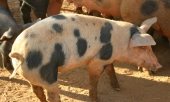posted 7 years ago
So, the small boar covering a larger sow makes sense, regardless of pedigree. Particularly with animals that drop multiple offspring per litter (hogs, rabbits, dogs, cats) a large-frame dam translates into plenty of room for fetal development. A Flemish giant rabbit carrying a litter from a standard sized sire is more likely to drop a dozen or more kits of reasonable size. By comparison, two standard sized parents will drop 6-8 kittens. When a sire's genetic traits outweighs that of the dam, there are fewer offspring littered, and more chances of issues that will require intervention (bottle-feeding for underfed or rejected offspring.) For a rather dramatic example, if a Chihuahua were to run off while in heat and get caught by a medium to large breed dog, presuming she survives the breeding process, she won't have room for more than one or two pups, and there's a better chance that she, they, or both will die in labor. Conversely, if, somehow, my male Chihuahua runs off again and finds a willing bird dog, she might well carry 6-8 puppies to term without issues because their Chihuahua genetics will reduce their overall size.
Anyway, back to the hogs. I grew up going to school with the daughters of a hog farmer who had a fairly successful breeding program for a handful of breeds, and made some pretty spunky crosses. Of particular note were those produced when he added a Berk boar to the herd. The Berk/Duroc piglets were relegated as feeders, and I, as well as many others, had great success with them. They put on weight like a Duroc, but the quality of carcass showed the Berk line. He saved back some of the gilts, and covered them with a Duroc boar, getting a red hog with a white shoulder belt. These hogs gained weight almost as well as the CAFO-lined Durocs, but were less likely to show apple-butt and other signs of being fatter than the market wanted because of that 1/4 of Berk.
The approach isn't so much survivor genetics as it is fine tuning the meat you want to produce. If we were looking for pure survivor genetics,there'd be a great opportunity for a Feral Hog Wrangler to ship his catch across the country for pastured pork producers.
Whatever it takes to dodge a time clock.

 1
1












































